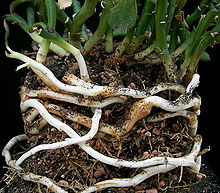Deleuze and Guattari's "Rhizome" was a particularly difficult read, which I found while tripping over my thoughts, grasping for whatever I'd learned in biology my sophomore year in high school.
I kept trying to find the correct roots in the term. This is the first image that comes up in a quick Google search:
However potentially confusing this development in critical theory may prove for those of us less well-versed in botanical terminology, it is clearly an appropriate allusion to hypertext. Like the literal rhizome roots displayed in the above image, rhizome in this context "connects any point to any other point, and its traits are not necessarily linked to traits of the same nature; it brings into play very different regimes of signs, and even nonsign states" (Deleuze & Guattari, 21) The rhizome is a key component in explaining the goals of hypertext (particularly in intertexuality and multivocality).
In the digital age, further development of links, the web, networks, and interweaving progresses in the form of alternatives to our previously beloved print culture. Hypertext presents a series of qualities representative of an assemblage (Deleuze & Guattari, 4), or a reconnection of ideas that aren't always impeded by a prior ideology, has multiple entryways and exits (Landow, 40), breaks away from the western mindset of starting in the middle (39), is primarily decentered (Landow, 36) and composed of linked texts that can always be recentered based on the reader's perception/recognition of ideas presented (Landow, 36). Hypertext is the ultimate acceptance of inevitable remix and remediation in order to further creativity and originality. It represents an attempt to transition from strict definitions and boundaries found society's understanding of genre.
According to Derrida, a revolution is taking place and "we need new ways to dismantle or to question" the values found in book (Landow, 47) For, "a book itself is a little machine; what's the relation (also measurable) of this literary machine to a war machine, love machine, revolutionary machine, etc.- and an abstract machine that sweeps them along? (Deleuze & Guattari, 4) This is a kind of multiplicity that works against any central or unified effort taken in a Western society to understand situations as a whole.
Carolyn Miller's "Genre as Social Action," advocates for an opposite society that can establish ways of acting together through conventional discourse, defines meaningful action based on a hierarchy of rules and symbolic interaction, and mediates the necessity of private intention and social exigence. (Miller, 163) The basic premise involves the idea that rhetorical situations recur, materialism is rejected due to the privileged investigation of the human condition, and recurrence is based on an understanding of comparison of social occurrences. The interactions between a writer/creator, the reader/consumer, and the text itself, is an example of how Western society defines a rhetorical situation.
Although there is significant difference in intention and ideals between these theorists, they both attempt to understand the world around them through, arguably, all too human endeavors. As Miller argues that humans understand recurrence through similarities, and create meaning from their interpretations (resulting in genre), Landow argues that hypertexts remind us of the histories of how we received texts and continue to receive them, revealing the undeniable existence of discourses (and their relevance to society).
"But what is at question in the rhizome...: all manner of becomings." (Deleuze & Guattari, 21) Rhizome is a subset within critical theory, aiding in the explanation of hypertext. This interweaving presents the best and worst of society's ideas, experience, beliefs, influence, and ideologies, based on our individual understanding and reading processes (the de facto organizing principle). Although a transformation is occurring in deconstructing historical texts by breaking down (or even transcending) boundaries between assumed genres and their mediums, Deleuze and Guattari's assemblage is a potential genre, bringing the shared experience of electronic literature into our history and discourse for this age.
~Jasmine Spitler

No comments:
Post a Comment
Note: Only a member of this blog may post a comment.